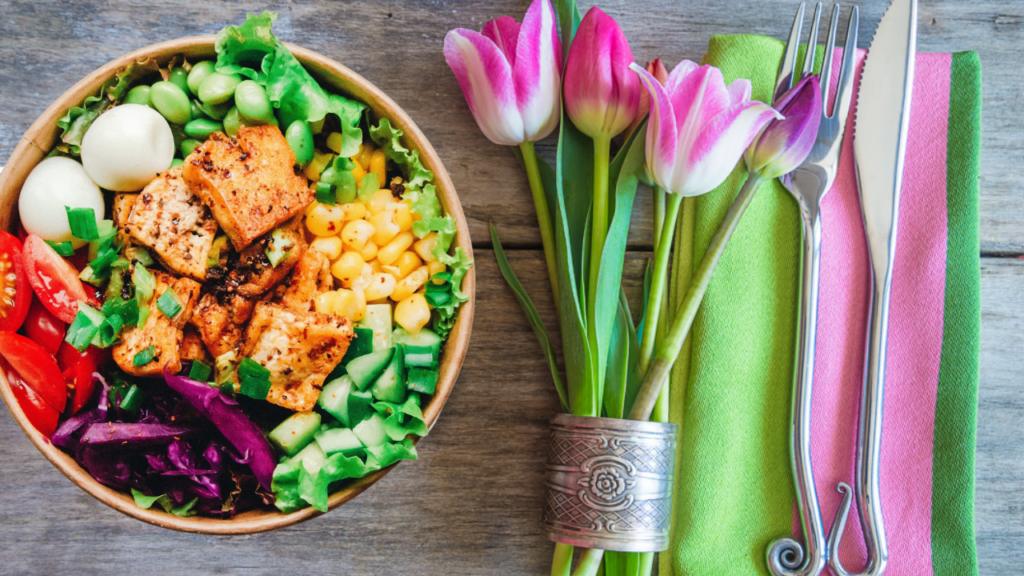
Chronic inflammation is a well-known precursor to a whole host of health issues, including heart disease, arthritis, and even some cancers. At Pain Free for Life, we firmly believe that inflammation is the root cause of all diseases.
Ann Wigmore, a pioneering holistic health advocate, has been quoted as saying:
“The food you eat can either be the safest and most powerful form of medicine,
or the slowest form of poison.”
And we couldn’t agree more. All this to say, paying attention to what we consume and how it affects our well-being is crucial. In this blog post, we’ll delve into the relationship between diet and inflammation and share three of our favorite healthy spring recipes to help alleviate inflammation.
What is Inflammation?
Inflammation is the body’s natural response to injury, infection, or illness. It’s not a bad thing, but it can go awry. Normal (or acute) inflammation is necessary for healing, but chronic inflammation involves the entire body and immune system.
Chronic inflammation is a long-term, low-level inflammation that can damage tissues and organs. According to Harvard, chronic inflammation can contribute to the development of various diseases, including:
- Heart disease
- Arthritis
- And cancer
Learn more about how inflammation affects your body in our blog, Inflammation: The Root of All Disease.
The Connection Between Diet and Inflammation: Key Points to Remember
Simply put, a healthy diet can help reduce inflammation in the body. Let’s explore some key points to keep in mind:
- Processed foods, sugary drinks, and fried foods can promote inflammation.
- Fruits, vegetables, whole grains, and healthy fats can reduce inflammation.
- Antioxidants can neutralize free radicals, harmful molecules that cause inflammation.
- A diet high in fiber can promote the growth of beneficial bacteria in the gut, which can reduce inflammation.
- A diet low in omega-6 fatty acids and high in omega-3 fatty acids can help reduce inflammation.
Spring Recipes That Reduce Inflammation:
At Pain Free For Life, we believe that diet plays a vital role in managing pain and promoting healing. However, we recognize that everyone’s body is unique and may respond differently to certain foods. That’s why we recommend consulting with your care team before making drastic changes in your diet for pain resolution.
Now that we’ve explored the connection between diet and inflammation, let’s dive into some delicious and nutritious recipes perfect for spring!
#1. Grilled Salmon with Avocado Salsa

This recipe pairs grilled salmon with a fresh and zesty avocado salsa that is packed with anti-inflammatory ingredients such as avocado, cilantro, and lime.
Ingredients:
- 4 salmon filets
- 1 avocado, diced
- 1 small red onion, diced
- 1/4 cup chopped fresh cilantro
- Juice of 1 lime
- Salt and pepper, to taste
Directions:
Preheat the grill to medium-high heat.
Season salmon filets with salt and pepper and grill for 4-5 minutes on each side, or until cooked through.
While the salmon is cooking, make the avocado salsa. In a medium bowl, combine diced avocado, red onion, cilantro, lime juice, salt, and pepper.
Serve the grilled salmon with the avocado salsa on top.
Add brown rice or quinoa on the side.
#2. Roasted Beet and Arugula Salad

This Roasted Beet and Arugula Salad is anti-inflammatory thanks to the combination of roasted beets, peppery arugula, and a tangy citrus dressing.
Note: Beets are particularly beneficial for reducing inflammation because they contain nitric oxide, a natural anti-inflammatory compound.
Ingredients:
- 4 medium beets, roasted and sliced
- 4 cups arugula
- 1/4 cup crumbled goat cheese (omit goat cheese if you have a sensitivity to dairy and replace with a vegan alternative or nutritional yeast flakes for a “cheesy” flavor.
- 1/4 cup chopped walnuts
- For the dressing:
- Juice of 1 lemon
- 2 tablespoons olive oil
- 1 teaspoon Dijon mustard
- Salt and pepper, to taste
Directions:
Preheat the oven to 375°F.
Wash beets and trim the ends. Place them in a baking dish and cover with foil. Roast for 45-60 minutes or until tender.
Remove beets from the oven and let them cool. Once cool, peel the skin off and slice the beets.
Combine arugula, sliced beets, crumbled goat cheese, and chopped walnuts in a large bowl.
Whisk together the lemon juice, olive oil, Dijon mustard, salt, and pepper in a small bowl to make the dressing.
Drizzle the dressing over the salad and toss to coat.
#3. Spring Veggie Stir-Fry with Coconut Aminos
This colorful stir-fry is packed with seasonal veggies and flavored with anti-inflammatory ginger, garlic, and coconut aminos. You can swap in or out any vegetables you like, depending on what’s in season or what you have on hand.
What are coconut aminos, you ask?

Coconut aminos are a great alternative to soy sauce because they are lower in sodium and offer several health benefits. Coconut aminos are made from the sap of coconut palms and are rich in amino acids, which are essential for building and repairing tissues in the body.
They are also free from soy, gluten, and other common allergens, making them a great option for those with dietary restrictions. In addition, coconut aminos are known to have anti-inflammatory properties, which can help reduce inflammation in the body and alleviate pain. However, it’s important to note that coconut aminos do contain some sodium, so it’s recommended to use them in moderation and go lightly on salt when using them in recipes.
And here’s an interesting fact: according to a 2015 article, coconuts possess various health properties, such as anti-inflammatory, antioxidant, antibacterial, antifungal, and antitumor.
Ingredients:
- 1 tablespoon coconut oil
- 1 tablespoon grated ginger
- 2 garlic cloves, minced
- 1 small onion, sliced
- 1 red bell pepper, sliced
- 1 zucchini, cubed or half-moons.
- 1 cup sliced mushrooms
- 1 cup snap peas
- 1 cup asparagus, cut into bite-sized pieces
- 2 tablespoons coconut aminos
- 2 tablespoons water
- Raw local honey, to taste (optional)
- Pepper, to taste
Directions:
Heat coconut oil in a large skillet over medium-high heat. Add grated ginger and minced garlic and cook for 1-2 minutes. Don’t overcook. Add sliced onion and cook for 2-3 minutes or until softened. Add sliced bell peppers, zucchini, mushrooms, snap peas, and asparagus to the skillet and cook for 5-7 minutes, or until vegetables are tender-crisp.
Whisk together aminos, water (optional honey), and pepper in a small bowl to make the sauce. If you’d like your sauce thicker and glossier, add an arrowroot or cornstarch slurry and heat up before dressing your stir-fry.
Pour the sauce over the vegetables and stir to coat.
Serve stir-fry over brown rice or quinoa if desired.
More Low-Inflammation Eating Resources
Check out these helpful resources from Pain Free for Life to learn more about low-inflammation eating and reducing chronic pain:
- Pain Resolution at Your Farmer’s Market: How Eating Right Can Reduce Chronic Pain – Learn how to shop for and prepare nutritious, low-inflammation foods from your local farmers’ market.
- Inflammation Foods to Avoid and What to Eat Instead – Discover which foods can trigger inflammation and what healthier options to choose instead.
- How to Cleanse for Pain Resolution: Dr. Rob’s Top Tips & Warnings – Find out how to safely and effectively cleanse your body to reduce inflammation and alleviate pain.
- 5 Healthy Foods to Increase Nitric Oxide Naturally & Reduce Nerve Pain – Learn about the benefits of nitric oxide for pain relief and which foods can naturally boost its production.
- Intuitively Eating for Health: Fresh, Healthy Recipes for Spring – Get inspired by these tasty and nutritious recipes that can help reduce inflammation and promote healing.
- Meat and Inflammation: The Shocking Connection – Learn about the link between meat consumption and inflammation and how to make healthier choices for reducing chronic pain.
Don’t forget to also check out Dr. Rob’s informative video on pain resolution through diet:
We hope these yummy recipes and resources have been helpful! Remember, making minor changes to your lifestyle can have a BIG impact on your health and well-being. If you have any questions or need support as you implement these strategies, please contact us at support@painfreeforlife.com.
We’re here to help you every step of the way.
Sources cited:
Understanding acute and chronic inflammation – Harvard Health
Coconut aminos: Health benefits and how to use it (medicalnewstoday.com)
Cocos nucifera (L.) (Arecaceae): A phytochemical and pharmacological review – PMC (nih.gov)





